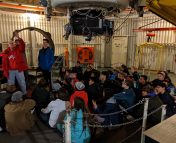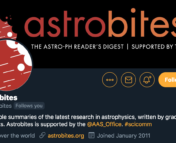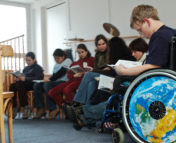We are starting a new series on outreach to showcase the various types of outreach activities you can do as a graduate student, as an undergraduate, or as an astronomer at any stage of your career! In each post, we’ll focus on one national organization and one local group.
National: Letters to a Pre-Scientist (by Briley Lewis)
What is Letters to a Pre-Scientist?
Getting a handwritten letter in the mail can be magical, especially as a kid. Letters to a Pre-Scientist (LPS) uses this personal form of communication to bring together elementary and middle school students (the “pre-scientists”) with science professionals. Each pre-scientist is assigned a pen-pal based on their interests, and they write four letters to each other over the course of a school year. Pre-scientists participate in this as an in-school activity, so every student in a participating class is matched with a scientist. Most of the schools involved serve low-income families, serving the goal of LPS to “demystify STEM careers” and “empower all students to see themselves as future scientists by creating personal connections between students from high-poverty schools and real scientists.”
Why did you want to be a scientist pen pal?
I love writing letters, and I love getting things in the mail, plain and simple. The idea of getting to cultivate a special one-on-one relationship with a kid who wants to talk about the universe and science just sounded so fun!
I also didn’t really know any professional scientists when I was growing up, and didn’t have an idea of what this career path was like (especially as a first generation PhD student). So, I hope to help another kid see what it’s like to be a scientist, and hopefully inspire them with some fun discussion about space and aliens along the way.
What do you do as a scientist pen pal?
When you sign up as a scientist pen pal, you’re committing to writing four letters throughout the school year to your pre-scientist.
The LPS leadership team is very helpful and communicative about when to expect letters in the mail and deadlines for when you need to send out your replies, so logistics are very easy for the participating scientists. Instead, you get to focus on writing fun, interesting, and age/reading level appropriate replies to your pre-scientist (and even including stickers and other little bonus gifts if you want). There’s a lot of support for scientist pen-pals, too, including a comprehensive training (before you start writing your letters) on specifics about the program and general tips for science communication with kids. Participating in LPS is a very low time commitment as a scientist, and it also brings so much joy and makes a direct impact with your pre-scientist by making STEM careers more accessible!
This sounds interesting! How could I get involved?
Are you a scientist of any kind? Pen pal matches happen every summer before the start of the school year. Keep an eye out for their next call for scientists – you can join their mailing list or follow them on Twitter (@LettersPreSci) to stay up to date with the program. (Just to clarify – for this program, a scientist means someone excited about communicating science with a student, whether you’re an undergrad, grad student, teacher, engineer, etc. So if you’re interested, you probably fit the description!)
Local: MIT Astrogazers (by Kaitlyn Shin)
Who are the MIT Astrogazers, and what do they do?
The MIT Astrogazers are an outreach group at MIT founded a few years ago by a visiting Martin Luther King Jr. Visiting Scholar, Dr. Duane Lee. Made up mostly of graduate students in the MIT Astrophysics division, we aim to share the magic of the night sky to people and communities that might not otherwise have the opportunities to experience them. We often set up telescopes on sidewalks around the Boston/Cambridge area (weather permitting!); by letting any passerby observe through them, we hope to spark a natural curiosity about space in a manner accessible to anyone.
Our “astrogazing” isn’t limited to just the night skies—we have a solar telescope for (safe) daytime views of the Sun. With this telescope, we can also observe special events such as the transit of Mercury across the Sun with the local public!
The MIT Astrogazers engage in outreach beyond local sidewalk astronomy as well. We participate in science festivals such as the annual Cambridge Science Festival and the Latino STEM Alliance Science Festival. Last summer, the MIT Astrogazers also did some hands-on activities at the S.T.E.A.M. Ahead Summer Learning Academy, for rising 5th and 6th grade students in Boston.
What do you love about MIT Astrogazers?
One of my fondest outreach memories at MIT so far happened while tabling with MIT Astrogazers at the Cambridge Science Festival Science Carnival & Robot Zoo last year. The Science Carnival happened to be three days after the Event Horizon Telescope (EHT) Collaboration released the first ever image of a black hole’s shadow. While I don’t work with the EHT Collaboration, black holes are what first got me into astrophysics as a starry-eyed little student, so I was beyond excited by their results.
Many people who stopped by our booth asked about the EHT results as well, and I had a blast chatting with them about the collaboration’s research and results. Black holes have been some of the most fascinating yet abstract astrophysical objects ever, and now we’ve imaged one(‘s shadow) directly—by turning the Earth itself into a ‘virtual radio telescope’! Most people shared my excitement, but one girl seemed rather bored until her mother asked me about Dr. Katie Bouman. I let the girl know that Dr. Bouman was one of the leaders within the collaboration, and that the image would not have been possible without her or other women scientists like her. Her eyes absolutely lit up, and she turned to her mother, smiling: “A woman scientist??”
I like what the MIT Astrogazers do. Can I do something similar at my own university?
Of course! Sidewalk astronomy requires acquiring (relatively portable) telescopes to observe with, which can be a little prohibitive as a start-up cost. For example, our Dobsonian telescopes were ~$600-800 each. However, good astronomical binoculars and tripods are a more affordable (and portable!) investment, and would still allow for good views of the Moon, some planets, and the Orion Nebula, at least around Boston.
Additionally, many activities that the MIT Astrogazers engage in don’t require a substantive budget. One recent activity, done for the S.T.E.A.M. Ahead Summer Learning Academy, was building CD spectroscopes. The materials were relatively inexpensive (~$100 for 40-50 spectroscopes), although it did take time and effort to prepare the activity so that it would be easily doable for a 5th or 6th grade student. A lot of additional hands-on science outreach ideas and lesson plans are available online for free! Also worth noting is we were able to obtain NASA swag (e.g. lithographs and stickers) to distribute at our events just by reaching out. Fortunately, there are endless ways that organizations like the MIT Astrogazers can get their start!




